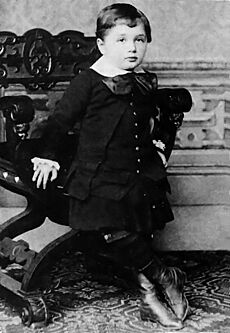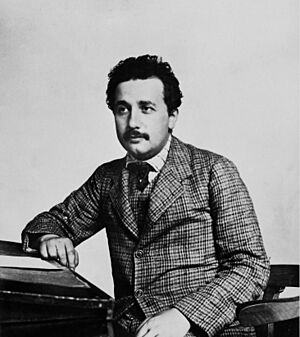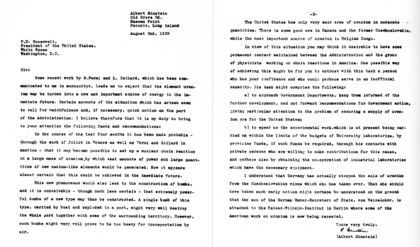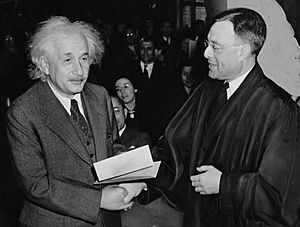Albert Einstein facts for kids
Quick facts for kids
Albert Einstein
|
|
|---|---|

Einstein in 1947
|
|
| Born | 14 March 1879 |
| Died | 18 April 1955 (aged 76) Princeton, New Jersey, U.S.
|
| Resting place | Ashes scattered at an undisclosed location |
| Citizenship |
|
| Education |
|
| Known for | |
| Spouse(s) | |
| Children |
|
| Family | Einstein |
| Awards |
See list
|
| Scientific career | |
| Fields | Physics |
| Institutions |
See list
|
| Doctoral advisor | Alfred Kleiner |
| Signature | |
Albert Einstein (born March 14, 1879 – died April 18, 1955) was a brilliant scientist born in Germany. He is famous for his amazing ideas about how the universe works, especially his theory of relativity. He was a theoretical physicist, which means he used math and deep thinking to figure out the rules of nature. Einstein also made big discoveries in quantum mechanics, another important part of physics.
His most famous idea is the formula E = mc². This equation shows that energy (E) and mass (m) are two forms of the same thing. It is known as "the world's most famous equation." In 1921, Einstein won the Nobel Prize in Physics. He received it for explaining the photoelectric effect, which showed that light can act like tiny particles.
Einstein was born in Germany. As a teenager, he moved to Switzerland. He later worked in a patent office, which gave him time to think about physics. In 1905, a year often called his "miracle year," he published four papers. These papers completely changed science.
When Adolf Hitler came to power in Germany in 1933, Einstein was visiting the United States. Since he was Jewish, he knew it was not safe to go back home. He stayed in the U.S. and became an American citizen in 1940. He warned President Franklin D. Roosevelt about the danger of Germany building an atomic bomb. This warning led the U.S. to start its own research.
Einstein is seen as one of the smartest and most important scientists ever. His work changed how we understand space, time, gravity, and the entire universe.
Contents
Einstein's Life and Career
Childhood and School Days
Albert Einstein was born in Ulm, Germany, on March 14, 1879. His parents were Hermann and Pauline Einstein. They were Ashkenazi Jews but did not practice their religion. When Albert was a young boy and sick, his father showed him a compass. Einstein was amazed by the invisible force that made the needle move. He later said he felt "something deeply hidden" was behind things.
He did not like the strict rules at his school in Munich. He felt that focusing only on memorizing facts stopped creativity. When his family moved to Italy, Einstein, then 15, stayed behind to finish school. But he soon left and joined his family.
From a young age, Einstein was very good at math and physics. By age 12, he was teaching himself advanced subjects. These included algebra and calculus. He even found his own way to prove the Pythagorean theorem. A family friend said Einstein's "mathematical genius was so high I could not follow."
At 16, he failed the general part of the entrance exam for a top school in Zurich, Switzerland. However, his scores in math and physics were excellent. He finished high school in Aarau, Switzerland, and graduated in 1896.
Working at the Patent Office
After college, Einstein found it hard to get a teaching job. In 1902, he got a job at the Swiss Patent Office in Bern. His work was to review new inventions. This job gave him a steady income and free time to think about physics.
The year 1905 is called Einstein's annus mirabilis (miracle year). He published four amazing science papers in a journal called Annalen der Physik. These papers covered:
- The photoelectric effect. This paper suggested that light is made of tiny packets of energy called quanta. These were later named photons. This was a key step in creating quantum theory.
- Brownian motion. This explained the random movement of tiny particles in a liquid. This gave strong proof that atoms and molecules exist.
- The special theory of relativity. This changed our ideas about space and time. It said that the speed of light is always the same for everyone.
- Mass–energy equivalence. This paper introduced the famous equation E = mc². It showed that mass can turn into a huge amount of energy.
These papers created the base for modern physics. They made him a rising star in the science world.
Becoming a Professor and Famous
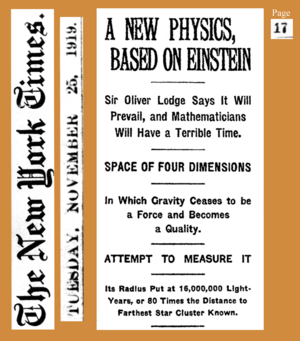
After his 1905 papers, universities started to notice Einstein. He left the patent office in 1908 and became a professor. He taught at universities in Bern, Zurich, and Prague. In 1914, he moved to Berlin. There, he joined the Prussian Academy of Sciences.
In 1915, he finished his general theory of relativity. This theory explained gravity. It said gravity is not a force. Instead, it is a curve in space and time. This curve is caused by mass and energy. One of his predictions was that gravity could bend light.
In 1919, a group of scientists led by Sir Arthur Eddington tested this idea. They did it during a solar eclipse. They measured light from distant stars as it passed the Sun. They found that the light did bend, just as Einstein had said.
When these results were announced, Einstein became famous very quickly. Newspapers around the world wrote headlines like "Revolution in Science." He was no longer just a respected scientist; he was a celebrity.
Family Life
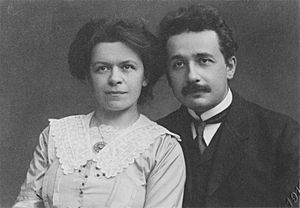
While studying in Zurich, Einstein met Mileva Marić. She was a fellow physics student from Serbia. They married in 1903. They had two sons, Hans Albert and Eduard. They also had a daughter named Lieserl before they married. What happened to her is not known.
Einstein and Marić divorced in 1919. Einstein promised to give her the money if he ever won a Nobel Prize. He won it two years later.

In 1919, Einstein married his cousin, Elsa Löwenthal. She was with him as he became famous. She also moved with him to the United States. Elsa died in 1936.
Einstein's younger son, Eduard, had serious mental health problems. He was diagnosed with schizophrenia. He spent much of his adult life in a hospital in Switzerland.
Moving to the United States
In the early 1930s, Einstein was a visiting professor in the United States. During this time, the Nazi party came to power in Germany. They were led by Adolf Hitler. The Nazis hated Jewish people. They made laws that removed them from jobs, including university positions.
As a famous Jewish scientist, Einstein was a target. The Nazis burned his books. They also offered money for his capture. In 1933, while in Belgium, Einstein realized he could not safely return to Germany. He gave up his German citizenship.
He accepted a job at the Institute for Advanced Study in Princeton, New Jersey. He worked there for the rest of his life. In 1940, he became a U.S. citizen. Einstein was thankful for the freedom he found in America. He said it was a place where people could think and say what they pleased.
World War II and the Atomic Bomb
In 1939, other scientists who had left Europe warned Einstein. They thought Nazi Germany might be trying to build an atomic bomb. They worried about what would happen if Hitler had such a powerful weapon.
Einstein was a pacifist, meaning he was against war. But he felt he had to do something. He and another scientist, Leó Szilárd, wrote a letter to U.S. President Franklin D. Roosevelt. The letter warned of the danger. It suggested that the U.S. start its own nuclear research.
This letter was a key reason for starting the Manhattan Project. This was a secret U.S. program that developed the atomic bomb. Einstein himself did not work on the project.
Later in life, Einstein said he regretted signing the letter. He said, "I made one great mistake in my life—when I signed the letter to President Roosevelt." He explained that he only did it because he feared the Germans would build the bomb first.
Final Years
Einstein spent his last years in Princeton. He kept trying to find a "unified field theory." This theory would connect all the forces of nature. He also spoke out for civil rights and peace. He called racism in America its "worst disease." He was a member of the NAACP.
On April 17, 1955, Einstein had a burst blood vessel. He was taken to the hospital. But he refused surgery. He said, "I want to go when I want... I have done my share; it is time to go. I will do it elegantly." He died the next morning at age 76.
His brain was removed after his death for scientific study. Scientists hoped it might show the secret of his genius. His ashes were scattered in a secret place, as he wished.
Einstein's Scientific Discoveries
Theory of Relativity
Einstein's most famous work is his theory of relativity. It has two main parts.
Special Relativity
In 1905, Einstein introduced his special theory of relativity. It is based on two main ideas:
- The laws of physics are the same for everyone who is not speeding up or slowing down.
- The speed of light in empty space is always the same. It does not matter how fast the person measuring it is moving.
These ideas led to strange but true conclusions. For example, a moving clock ticks slower than a clock that is still. This is called time dilation. Also, an object gets shorter in the direction it moves as it goes faster. This is called length contraction. Special relativity also led to his famous equation, E = mc².
General Relativity
Einstein published his general theory of relativity in 1915. This theory explains gravity. Instead of gravity being a force that pulls objects together, Einstein showed something new. He said gravity is how mass and energy bend or curve spacetime.
Imagine spacetime as a trampoline. If you put a heavy bowling ball in the center, it makes a dip. If you then roll a marble nearby, it will curve and fall toward the bowling ball. Einstein said this is how gravity works. Planets orbit the Sun because they follow the curve in spacetime made by the Sun's huge size.
This theory also predicted black holes and gravitational waves. Gravitational waves are ripples in spacetime. Scientists have now confirmed both of these predictions.
Quantum Theory
Einstein was one of the people who started quantum theory. His 1905 paper on the photoelectric effect suggested that light is made of particles called photons. This idea helped explain how light can knock electrons out of a metal.
However, Einstein was not fully comfortable with some parts of quantum mechanics. He did not like the idea that the universe is based on randomness. He famously said, "God does not play dice." He had many debates with another famous physicist, Niels Bohr, about what quantum mechanics truly meant.
Einstein's Legacy
Albert Einstein is one of the most celebrated scientists in history. His theories of relativity changed how we see the universe. His work on quantum theory helped start a new area of physics.
His name has become a word for "genius." In 1999, Time magazine named him "Person of the Century." The chemical element einsteinium was named to honor him.
Beyond his science, Einstein is remembered as a great thinker. He cared about humanity. He used his fame to speak out for peace, freedom, and fairness for everyone. His ideas still inspire scientists and people all over the world.
Albert Einstein Quotes
- "Only a life lived for others is a life worthwhile."
- "We cannot solve our problems with the same thinking we used when we created them."
- "I have no special talent. I am only passionately curious."
- “If you want your children to be intelligent, read them fairy tales. If you want them to be more intelligent, read them more fairy tales.”
- “Logic will get you from A to Z; imagination will get you everywhere.”
- “Anyone who has never made a mistake has never tried anything new.”
- “I speak to everyone in the same way, whether he is the garbage man or the president of the university.”
- “The important thing is not to stop questioning. Curiosity has its own reason for existence."
Interesting Facts About Albert Einstein
- Albert left school at age 15. By then, he had already mastered differential and integral calculus.
- He gave up his German citizenship at age 16.
- He played the violin and owned one he named Lina.
- Albert never learned to swim but liked to sail. He owned a boat named Tinef, which means “worthless” in Yiddish.
- Albert married Mileva Marić, the only female student in his physics class.
- He promised his Nobel Prize money to Mileva if she would divorce him.
- Albert’s second wife was his first cousin.
- Albert’s son, Eduard, was in a hospital for most of his adult life. He was diagnosed with schizophrenia.
- Albert had a habit of not wearing socks.
- The person who designed the eyes and wrinkles for Yoda (from Star Wars) based them on Einstein’s features.
- He smoked a pipe.
- The FBI spied on him for 22 years.
- Albert Einstein’s brain was taken for study after his death.
Images for kids
-
Einstein with actor Charlie Chaplin at a movie premiere in 1931.
See Also
 In Spanish: Albert Einstein para niños
In Spanish: Albert Einstein para niños


